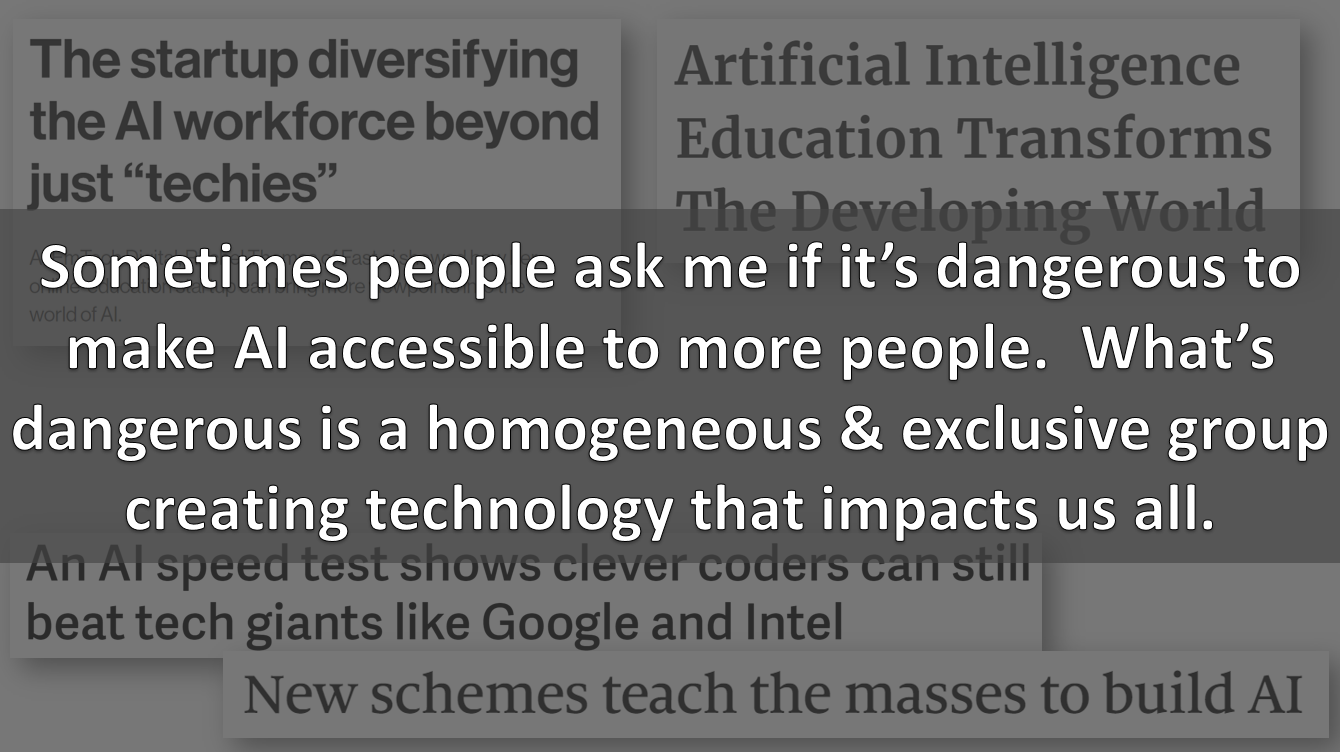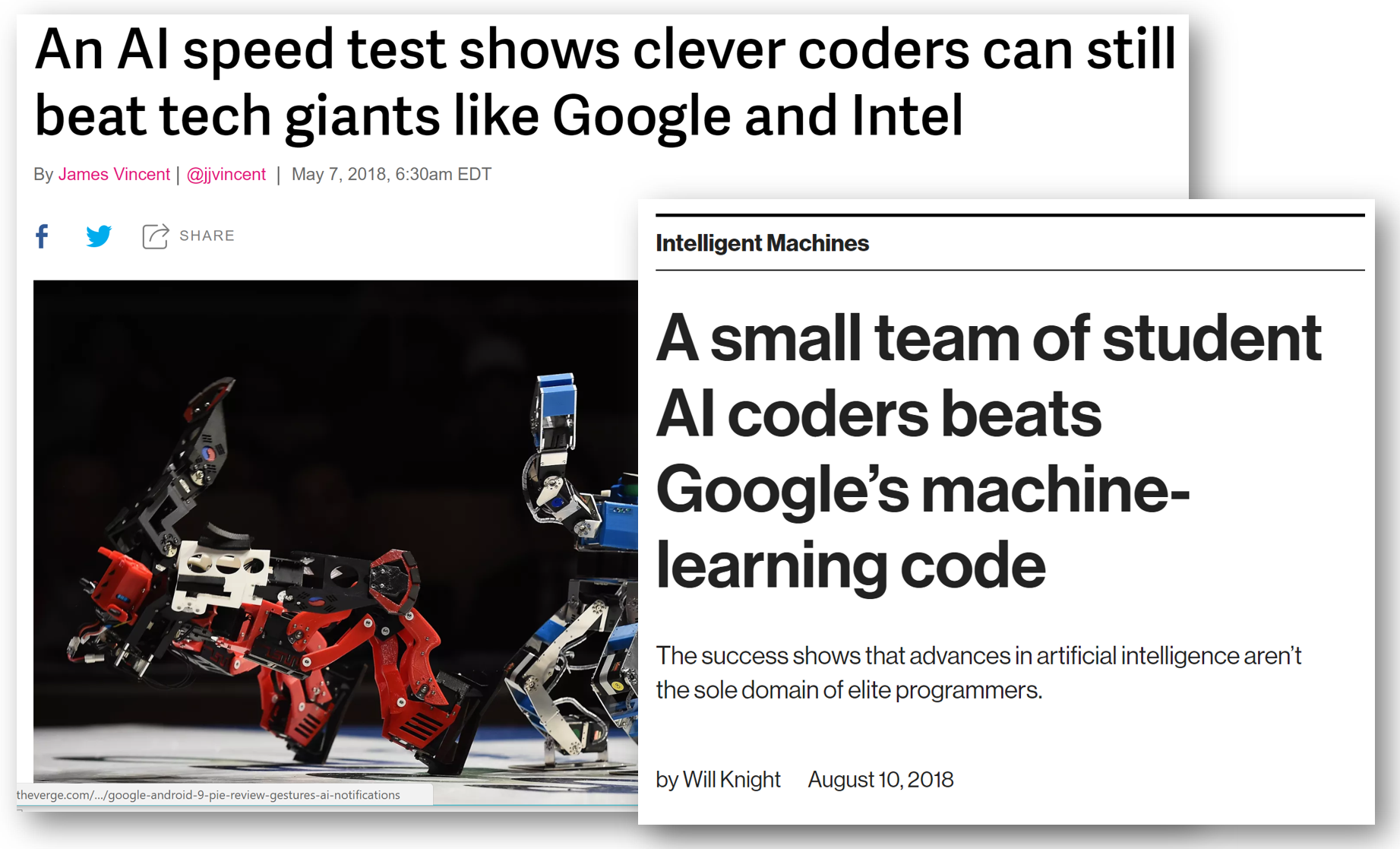This post was originally published on 2018-08-16, but has been updated for the newest, upcoming course.
At fast.ai, we want to do our part to increase diversity in deep learning and to lower the unnecessary barriers to entry for everyone. We are providing diversity scholarships for our updated part-time, in-person Deep Learning for Coders part 2 course presented in partnership with the University of San Francisco Data Institute, to be offered one evening per week for 7 weeks, starting March 18, 2019, in downtown San Francisco. Women, people of Color, LGBTQ people, people with disabilities, and/or veterans are eligible to apply. We are still looking for additional financial sponsors, so please contact [email protected] if your company is interested in donating.
The deadline to apply is February 14, 2019. Details on how to apply, and FAQ, are at the end of this post.
- What can you do with deep learning?
- The fast.ai approach
- How to sponsor
- Who is eligible?
- How to apply
- FAQ
What can you do with deep learning?
Deep learning has great potential for good. It is being used by fast.ai students and teachers to diagnose cancer, stop deforestation of endangered rain-forests, provide better crop insurance to farmers in India (who otherwise have to take predatory loans from thugs, which have led to high suicide rates), help Urdu speakers in Pakistan, detect udder infections in goats and cows, develop wearable devices for patients with Parkinson’s disease, and much more. Deep learning could address the global shortage of doctors, provide more accurate medical diagnoses, improve energy efficiency, increase farm yields, and reduce pesticide use.
However, there is also great potential for harm. We are worried about unethical uses of data science, and about the ways that society’s racial and gender biases (summary here) are being encoded into our machine learning systems. We are concerned that an extremely homogeneous group is building technology that impacts everyone. People can’t address problems that they’re not aware of, and with more diverse practitioners, a wider variety of important societal problems will be tackled.
We want to get deep learning into the hands of as many people as possible, from as many diverse backgrounds as possible. People with different backgrounds have different problems they’re interested in solving. The traditional approach is to start with an AI expert and then give them a problem to work on; at fast.ai we want people who are knowledgeable and passionate about the problems they are working on, and we’ll teach them the deep learning they need. In my TEDx talk, I shared how my unlikely background led me to the work I do now and why we need more people with unlikely backgrounds in the field, both to address misuses of AI, as well as to take full advantage of the positive opportunities.

While some people worry that it’s risky for more people to have access to AI; I believe the opposite. We’ve already seen the harm wreaked by elite and exclusive companies such as Facebook, Palantir, and YouTube/Google. Getting people from a wider range of backgrounds involved can help us address these problems.
The fast.ai approach
We began fast.ai with an experiment: to see if we could teach deep learning to coders, with no math pre-requisites beyond high school math, and get them to state-of-the-art results in just 7 weeks. This was very different from other deep learning materials, many of which assume a graduate level math background, focus on theory, only work on toy problems, and don’t even include the practical tips. We didn’t even know if what we were attempting was possible, but the fast.ai course has been a huge success!
Fast.ai students have been accepted to the launched companies, won hackathons, invented a new fraud detection algorithm, had work featured on the HBO TV show Silicon Valley, and more, all from taking a course that has only one year of coding experience as the pre-requisite.

fast.ai is not just an educational resource; we also do cutting-edge research and have achieved state-of-the-art results. Our wins (and here) in Stanford’s DAWNBench competition against much better funded teams from Google and Intel were covered in the MIT Tech Review and the Verge. Jeremy’s work with Sebastian Ruder achieving state-of-the art on 6 language classification datasets was accepted by ACL, has been built upon by OpenAI and Google Brain; and was featured in the New York Times. All this research is incorporated into our course, teaching students state-of-the-art techniques.
How to Sponsor
We are looking for additional companies to sponsor diversity fellowships. Please contact Mindi [email protected] if your company might be interested!
Who is eligible for a diversity fellowship?
Wondering if you’re qualified? The requirements are:
- Familiarity with Python, git, and bash
- Familiarity with the content covered in Deep Learning Part 1, v3 (available for free online), including the fastai library, a high-level wrapper for PyTorch (it’s OK to start studying this material now, as long as you complete it by the start of the course)
- Curiosity and a willingness to work hard
- Able to commit 10 hours a week of study to the course (includes time for homework).
- Identify as a woman, person of Color, LGBTQ person, person with a disability, and/or veteran
- Be available to attend in-person 6:30-9pm in downtown San Francisco, one evening per week (exact schedule found here under details, day of the week varies)
You can fulfill the requirement to be familiar with deep learning, the fastai library, and PyTorch by doing any 1 of the following:
- You took the updated, in-person deep learning part 1 course during fall 2018
- You have watched the first 2 videos of the online course before you apply, and a commitment to work through all 7 lessons before the start of the course. We estimate that each lesson takes approximately 10 hours of study (so you would need to study for the 7 weeks prior to the course starting on March 18, for 10 hours each week).
- You have previously taken the older version of the course (released last year) AND watch the first 4 lessons of the new course to get familiar with the fastai library and PyTorch.
Deep Learning Part 1 covers the use of deep learning for image recognition, recommendation systems, sentiment analysis, and time-series prediction. Part 2 will take this further by teaching you how to read and implement cutting edge research papers, generative models and other advanced architectures, and more in-depth natural language processing. As with all fast.ai courses, it will be practical, state-of-the-art, and geared towards coders.
How to Apply for a Fellowship
The number of scholarships we are able to offer depends on how much funding we receive (if your organization may be able to sponsor one or more places, please let us know). To apply for the fellowship, you will need to submit a resume and statement of purpose. The statement of purpose will include the following:
- 1 paragraph describing one or more problems you’d like to apply deep learning to
- 1 paragraph describing previous machine learning education or experience (e.g. fast.ai courses, Coursera, deeplearning.ai,…)
- which under-indexed group(s) you are a part of (gender, race, sexual identity, veteran)
Diversity Fellowship applications should be submitted here: https://certificate.usfca.edu/register/di-application
If you have any questions, please email [email protected].
The deadline to apply is February 14, 2019.
FAQ
I’m not eligible for the diversity scholarship, but I’m still interested. Can I take the course? Absolutely! You can register here.
I don’t live in the San Francisco Bay Area; can I participate remotely? Yes! Stay tuned for details to be released in a blog post in the next few weeks.
Will this course be made available online later? Yes, this course will be made freely available online afterwards. Benefits of taking the in-person course include earlier access, community and in-person interaction, and more structure (for those that struggle with motivation when taking online courses).
Is fast.ai able to sponsor visas or provide stipends for living expenses? No, we are not able to sponsor visas nor to cover living expenses.
How will this course differ from the previous fast.ai courses? Our goal at fast.ai is to push the state-of-the-art. Each year, we want to make deep learning increasingly intuitive to use while giving better results. With our fastai library, we are beating our own state-of-the-art results from last year.
What language is the course taught in? The course is taught in Python, using the fastai library and PyTorch. Some of our students have gone on to use the fastai library in production at Fortune 500 companies.